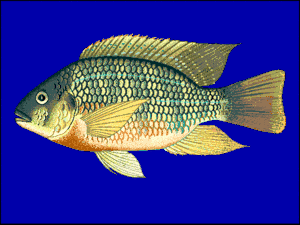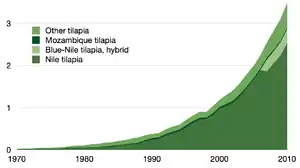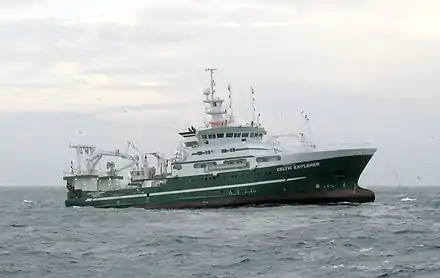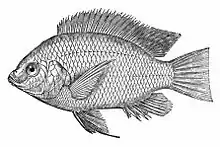Aquaculture of tilapia
Tilapia has become the third most important fish in aquaculture after carp and salmon; worldwide production exceeded 1.5 million metric tons (1.5×106 long tons) in 2002[2] and increases annually. Because of their high protein content, large size, rapid growth (6 to 7 months to grow to harvest size),[3] and palatability, a number of coptodonine and oreochromine cichlids—specifically, various species of Coptodon, Oreochromis, and Sarotherodon—are the focus of major aquaculture efforts.
Tilapia fisheries originated in Africa and the Levant. The accidental and deliberate introductions of tilapia into South and Southeast Asian freshwater lakes have inspired outdoor aquaculture projects in various countries with tropical climates, including Honduras,[4] Papua New Guinea, the Philippines, and Indonesia.[5] Tilapia farm projects in these countries have the highest potential to be "green" or environmentally friendly. In temperate zone localities, tilapia farmers typically need a costly energy source to maintain a tropical temperature range in their tanks. One relatively sustainable solution involves warming the tank water using waste heat from factories and power stations.
Tilapiines are among the easiest and most profitable fish to farm due to their omnivorous diet, mode of reproduction (the fry do not pass through a planktonic phase), tolerance of high stocking density, and rapid growth. In some regions the fish can be raised in rice fields at planting time and grow to edible size (12–15 cm, 5–6 in) when the rice is ready for harvest. Unlike salmon, which rely on high-protein feeds based on fish or meat, commercially important tilapiine species eat a vegetable or cereal-based diet.
Tilapia raised in inland tanks or channels are considered safe for the environment, since their waste and disease is contained and not spread to the wild.[6] However, tilapiines have acquired notoriety as being among the most serious invasive species in many subtropical and tropical parts of the world. For example, blue tilapia (Oreochromis aureus) (itself commonly confused with another species often used in aquaculture, the Nile tilapia, O. niloticus), Mozambique tilapia (O. mossambicus), blackchin tilapia (Sarotherodon melanotheron), spotted tilapia (Pelmatolapia mariae), and redbelly tilapia (Coptodon zillii) have all become established in the southern United States, particularly in Florida and Texas.[7]
Commercially grown tilapia are almost exclusively male. Being prolific breeders, female tilapia in the ponds or tanks will result in large populations of small fish. Whole tilapia can be processed into skinless, boneless (PBO) fillets: the yield is from 30% to 37%, depending on fillet size and final trim.[8]
Nutritional value
Tilapia from aquaculture contain especially high ratios of omega-6 to omega-3 fatty acids.
Around the world
Apart from the very few species found in the Western Asia, such as the Middle Eastern mango tilapia, there are no tilapia cichlids native to Asia. However, species originally from Africa have been widely introduced and have become economically important as food fish in many countries. China, the Philippines, Taiwan, Indonesia and Thailand are the leading suppliers, and these countries altogether produced about 1.1 million metric tons (1.1×106 long tons) of fish in 2001, constituting about 76% of the total aquaculture production of tilapia worldwide.[2]
| Production of farmed tilapia from the top 20 countries in 2017 | |||
|---|---|---|---|
| Country | Tonnes | Notes | |
| China | 1,188,480 | In mainland China, tilapia is called (羅非魚; luófēiyú) in Mandarin that is ultimately based on the Vietnamese word, cá rô phi.[9] | |
| Indonesia | 1,260,000 | In Indonesia, tilapia are known as ikan nila. Tilapia were introduced to Indonesia in 1969 from Taiwan. Later, several species also introduced from Thailand (Nila Chitralada), Philippines (Nila GIFT) and Japan (Nila JICA). Tilapia has become popular with local fish farmers because they are easy to farm and grow fast. Major tilapia production areas are in West Java and North Sumatra. In 2006, Badan Pengkajian dan Penerapan Teknologi (Agency for the Assessment and Application of Technology) and Balai Besar Pengembangan Budidaya Air Tawar (Main Center for Freshwater Aquaculture Development – MCFAD), Indonesian government research, development and introduced a new species named "genetically supermale Indonesian tilapia" (GESIT). GESIT fish are genetically engineered to hatch eggs that will produce 98% - 100% male tilapia. Monosex culture (all male) is more productive and will benefit the farmers. Now, around 14 strains of ikan nila have been developed by contributions from research institutes including MCFAD. | |
| Egypt | 967,301 | ||
| Brazil | 290,075 | ||
| Philippines | 267,735 | In the Philippines, several species of tilapia have been introduced into local waterways and are farmed for food. Tilapia fish pens are a common sight in almost all the major rivers and lakes in the country, including Laguna de Bay, Taal Lake, and Lake Buhi.
Locally, tilapia are also known as "pla-pla". Tilapiine cichlids have many culinary uses, including fried, grilled, sinigang (a sour soup using tamarind, guava, calamansi or other natural ingredients as a base), paksiw (similar to sinigang, only it uses vinegar) and many more recipes. On January 11, 2008, the Cagayan Bureau of Fisheries and Aquatic Resources (BFAR) stated that tilapia production grew and Cagayan Valley is now the Philippines' tilapia capital. Production grew 37.25 percent since 2003, with 14,000 tonnes (MT) in 2007. The recent aquaculture congress found the growth of tilapia production was due to government interventions: provision of fast-growing species, accreditation of private hatcheries to ensure supply of quality fingerlings, establishment of demonstration farms, providing free fingerlings to newly constructed fishponds, and the dissemination of tilapia to Nueva Vizcaya (in Diadi town). | |
| Vietnam | 235,311 | ||
| Thailand | 203,696 [10] | The red hybrid is known in Thai language as pla thapthim (Thai: ปลาทับทิม), whereas the black and silver striped hybrid is known as pla nin (Thai: ปลานิล; lit. "Nile fish"). Both hybrids of tilapia O. niloticus are very popular in Thai cuisine.[11]
Some 300,000 farmers in Thailand raise species of tilapia.[10] In March 2007, millions of caged tilapia in the Chao Phraya River died as a result of oxygen deprivation.[12] |
|
| Taiwan | 61,711 | In Taiwan, tilapiine cichlids are also known as the "South Pacific crucian carp", and since their introduction, have spread across aquatic environments all over the island. Introduced in 1946, tilapiine cichlids made a considerable economic contribution, not only by providing the Taiwanese people with food, but also by allowing the island's fish farmers to break into key markets, such as Japan and the United States. Indeed, tilapiine cichlids have become an important farmed fish in Taiwan for both export and domestic consumption.[13]
The Chinese name for the fish in Taiwan is wu-kuo (吳郭), and was created from the surnames of Wu Chen-hui (吳振輝) and Kuo Chi-chang (郭啟彰), who introduced the fish into Taiwan from Singapore. The Taiwan tilapia is a hybrid of Oreochromis mossambicus and O. niloticus niloticus. | |
| Colombia | 63,450 | ||
| Myanmar | 33,755 | ||
| Malaysia | 32,526 | ||
| Ecuador | 23,050 | ||
| Uganda | 31,670 | ||
| Bangladesh | 24,823 | ||
| Costa Rica | 23,034 | ||
| Laos | 20,580 | ||
| Honduras | 16,455 | In Spanish, tilapia are simply known as tilapia. Formal tilapia farming is relatively new to Honduras but the commercial export market is expanding rapidly. The first audit of a Honduran tilapia fishery was conducted in 2010 and the facility was found to be compliant with international standards. Honduran aquafarmers are now exporting nearly 20 million pounds of the fish every year, leading tilapia to become viewed as a promising commodity for the developing nation. Joint efforts among community farm training centers, a nonprofit Honduran microfinance group, FEHMISSE, and foreign investors are assisting local entrepreneurs as they establish and maintain environmentally sound tilapia farms. | |
| Nigeria | 11,989 | ||
| Zambia | 10,208 | ||
| United States | 9,979 | The geographic range for tilapia culture is limited by their temperature-sensitivity. For optimal growth, the ideal water temperature range is 82 to 86 °F (28 to 30 °C), and growth is reduced greatly below 68 °F (20 °C). Death occurs below 50 °F (10 °C). Therefore, only the southernmost states are suitable for tilapia production. In the southern region, tilapia can be held in cages from five to 12 months per year, depending on location.[14] About 1.5 million tons of tilapia were consumed in the US in 2005, with 2.5 million tons projected by 2010.[15] | |
| Other countries | 79,335 | ||
| TOTAL PRODUCTION | 3,497,391 | ||
India
The FAO has not recorded any production of farmed tilapia by India.[1] Rajiv Gandhi Centre for Aquaculture (RGCA), the R&D arm of Marine Products Export Development Authority, has established a facility in Vijayawada to produce mono-sex tilapia in two strains. This project involves the establishment of a satellite nucleus for the GIFT strain of tilapia in India, the design and conduct of a genetic improvement program for this strain, the development of dissemination strategies, and the enhancement of local capacity in the areas of selective breeding and genetics. The development and dissemination of a high yielding tilapia strain possessing desirable production characteristics is expected to bring about notable economic benefits for the country. Farming of Tilapia is not permitted in the country on commercial basis. The Rajiv Gandhi Center for Aquaculture (RGCA) has expressed interest in obtaining the Genetically Improved Farmed Tilapia (GIFT strain) for aquaculture development in the country. The GIFT tilapia strain, selectively bred in Malaysia and the Philippines, has achieved an improvement of more than 10 per cent per generation in growth rate and has been widely distributed to several Asian countries and to Latin America (Brazil). However, rather than passively importing the improved genetic stock, the Center is interested in running a formal breeding program (fully pedigreed population) similar to the one that has been carried out for the GIFT strain in Malaysia.
The aim is to produce fast-growing high yielding tilapia strains adapted to a wide range of local farming environments that can be grown at as low a cost as possible.
The project involves several steps. The first is the establishment of a new nucleus of the GIFT strain at the RGCA and the design of a formal breeding program to further improve its genetic performance within the local environment. This will involve enhancing the capacity of local personnel in selective breeding, genetic improvement, statistical analysis and hatchery management through specialized training courses.
Once a high performing tilapia strain (or strains) has been developed, the establishment of satellite hatcheries will increase the availability and decrease the costs of seed stock. These public and private hatcheries will act as multipliers for the superior genetics developed at RGCA and the sites for dissemination of quality broodstock to fish farmers.
Although the ultimate target groups of this project are fish farmers and small householders, a wider range of beneficiaries is expected, including commercial producers, scientists and the end consumers. The RGCA will gain experience and knowledge on the development of genetic improvement programs for economically important traits and other aspects of modern quantitative genetics. This experience and the development of a standard selective breeding protocol will allow for genetic improvement programs for other aquaculture species that are commonly cultured in India. Hatchery managers, producers and farmers will also improve their capacity to implement on-farm selective breeding programs.
In the longer term the project is also expected to contribute to the development of a complete chain of production. This will require initial capital support for farmers, identification of alternative cheap plant-based feed, and diagnosis of diseases in hatcheries, as well as strategies for early growth management. Improvement in harvest technologies, including storage of product and transport facilities, is likely to improve as a consequence of this project.
Malawi
In 2010 Malawi produced 2,997 tonnes of farmed tilapis.[1] A few species of Oreochromis tilapia, popular known as 'chambo', are the most popular fish in Malawi.[16] They are endemic to bodies of water in Malawi like Lake Malawi, Lake Malombe and the Shire River.[17] Due to over fishing, the fish however is now on the threatened species list.[17] Malawi has fish farms that are dedicated to farming tilapia.
 National Tilapia Research and Development Program (NTRDP)[18] – Red Nile Tilapia Aquaculture of tilapia [19] Nile tilapia Oreochromis niloticus
National Tilapia Research and Development Program (NTRDP)[18] – Red Nile Tilapia Aquaculture of tilapia [19] Nile tilapia Oreochromis niloticus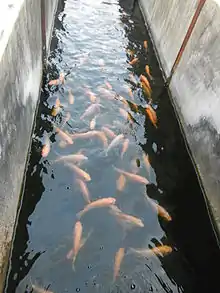 Red nile tilapia under the experiment (CLSU, Philippines.)
Red nile tilapia under the experiment (CLSU, Philippines.) Red nile tilapia for breeding
Red nile tilapia for breeding The fingerlings in breeding tubes
The fingerlings in breeding tubes Water sprinklers for aeration of the fingerlings
Water sprinklers for aeration of the fingerlings Pond
Pond
See also
- List of harvested aquatic animals by weight
- Tilapia as exotic species
- Tilapia (genus)
Notes
- Based on data sourced from the FishStat database Archived November 7, 2012, at the Wayback Machine
- Fessehaye, Yonas (2006). Natural mating in Nile tilapia (Oreochromis niloticus L.) Implications for reproductive success, inbreeding and cannibalism (PDF). Wageningen: Wageningen UR. pp. 150 pp. ISBN 90-8504-540-1.
- "Research & Advocacy". gaalliance.org. Archived from the original on 2012-11-09.
- "Archived copy". Archived from the original on 2012-08-21. Retrieved 2012-05-15.CS1 maint: archived copy as title (link)
- "Archived copy". Archived from the original on 2006-05-17. Retrieved 2007-01-28.CS1 maint: archived copy as title (link)
- Rogers, Paul. "Economy of Scales". Stanford Magazine. Stanford Alumni Association (March / April 2006). Archived from the original on 2008-06-11. Retrieved 2008-02-13.
- Non-Native Aquatic Species Summaries Archived January 25, 2007, at the Wayback Machine
- LLC, Richard Xiao, Mr Trade Group. "Tilapia farming, tilapia nutrient, healthy seafood, protein, omega-3". www.mytilapia.com. Retrieved 6 April 2018.
- Li, Sizhong (1999). "鱼名漫谈(一)"罗非鱼"名称的来源". 科技术语研究 (in Chinese) (2). Archived from the original on 2019-05-14. Retrieved 2020-01-27.
- Norapoompipat, Apipar (6 December 2016). "A Gift from the King". Bangkok Post. Retrieved 6 December 2016.
- "All About CP Foods and What We Have to Offer To Casino Lovers". cpfoods.net. Archived from the original on 10 September 2009. Retrieved 6 April 2018.
- "Up to one million fish found dead in Thai river". Yahoo! News. 2007-03-13. Archived from the original on 2007-03-19. Retrieved 2007-03-13.
- Taiwan Tilapia Alliance Archived December 31, 2006, at the Wayback Machine
- "Andrew S. McGinty, A.S. And Rakocy, J.E. Cage Culture of Tilapia Oklahoma Cooperative Extension Service, SRAC 281" (PDF). okstate.edu.
- Wake Forest University Baptist Medical Center (2008, July 10). Popular Fish, Tilapia, Contains Potentially Dangerous Fatty Acid Combination. ScienceDaily. Retrieved July 11, 2008, from www.sciencedaily.com
- "Oreochromis lidole". malawicichlids.com.
- "Oreochromis lidole". IUCN Red List of Threatened Species.
- "CLSU-FAC". fac.clsu.edu.ph. Retrieved 6 April 2018.
- "Red tilapia". www.aquaticcommunity.com. Retrieved 6 April 2018.
References
- Lim C and Webster CD (eds.) (2006) Tilapia: Biology, Culture, and Nutrition Routledge. ISBN 978-1-56022-318-4.
- Parker R and Parker RO (2011) Aquaculture Science Pages 123–128, Cengage Learning. ISBN 978-1-4354-8812-0.
- Sayed, A.-F. M. (2006) Tilapia Culture CABI. ISBN 978-0-85199-014-9.
- Tilapia, ITIS Standard Report. (2004-05-11)
- Tilapias as alien aquatics in Asia and the Pacific: a review FAO report
- Managing Iowa Fisheries: Tilapia Culture in Iowa
- The effects of introduced tilapias on native biodiversity
- Another Side of Tilapia, The Perfect Factory Fish
External links
- American Tilapia Association
- Taiwan Tilapia Alliance
- Tilapia project at Australian Centre for Tropical Freshwater Research, James Cook University
- Information on two tilapia pest species from the Australian Centre for Tropical Freshwater Research as PDF downloads
- Start Up & Success Tips For Tilapia Fish Farming Owners
- Gallery of Earth Ponds and Cages Fish Farming
- Tilapia Health, Diagnosis, and Treatment Advice
- Aquaculture tilapia fish farm YouTube.
- http://www.thehindu.com/news/national/tamil-nadu/a-second-coming-for-tilapia-in-south-tamil-nadu/article9286888.ece
